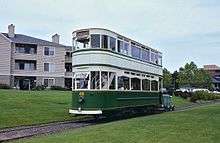Oregon Electric Railway Museum

The Oregon Electric Railway Museum is the largest streetcar/trolley museum in the Pacific Northwest of the United States. It is owned and operated by the Oregon Electric Railway Historical Society and is located in Brooks, Oregon, on the grounds of Antique Powerland.[1]
The original museum opened in Glenwood, about 40 miles west of Portland, in 1959, with the first operation of streetcars taking place in 1963[2][3] and regular operation in 1966.[4] It was named Trolley Park or, more commonly, the Trolley Park, but its formal name in later years was the same as that of the present museum. The Glenwood museum was built on the site of a former steam logging railroad,[2][5] and OERHS re-equipped the former sawmill building of the Consolidated Timber Company as a four-track carbarn.[3] The museum property occupied about 26 acres (11 ha),[6] and trolley cars were able to operate on a 1.7-mile (2.7 km) line.[5]
Operation at the Glenwood site ended in autumn 1995.[2]
The current museum opened in Brooks in 1996. The museum consists of about one mile of mainline track with overhead wire. There is a four-track carbarn to store the international collection of streetcars.
The collection includes:


- Two Portland 1904 Brill streetcars (nicknamed Council Crest type), Nos. 503 and 506[7]
- Portland 1932 Brill "Master Unit", No. 813
- Portland-built interurban, No. 1067
- Blackpool, England, double-decker tram, No. 48, built in 1928. Acquired by OERHS in 1964.[3]
- Sydney, Australia, open-sided "Breezer" streetcar, No. 1187, built in 1912
- Porto, Portugal single-truck streetcar, No. 210
- Los Angeles Railway car No. 1318
- Two San Francisco PCC streetcars, Nos. 1118 and 1159
- San Francisco Boeing LRV, No. 1213
- Hong Kong double-decker tram, No. 12
- Portland snow sweeper, No. 1455[8]
- Three electric locomotive "steeple cabs"
- Three types of trolley buses: a Twin Coach and a Pullman-Standard from Seattle and a CCF-Brill from Vancouver
One of the two Portland "Council Crest" Brill cars, No. 503, was loaned to San Francisco in 1983,[9] and again in 1985, for operation in the "San Francisco Historic Trolley Festival", predecessor of the F Market & Wharves heritage streetcar line.[10] In the late 1980s, Portland's transit agency, Tri-Met, used cars 503 and 506 as the models for new replica-vintage streetcars it was planning to purchase for use on the then-planned Portland Vintage Trolley service.[11] Four faux-vintage Council Crest cars were eventually built by the Gomaco Trolley Company.[11]
The museum is open from May through October with trolley operations on Saturdays. The big event of the year is the annual Steam-Up, held on the last weekend of July and the first weekend of August. Thousands of riders use the trolley during these two weekends.
See also
References
- ↑ "Oregon Electric Railway Museum (Trolley Museum)". OERHS. Retrieved 2009-12-21.
- 1 2 3 Young, Andrew D. (1997). Veteran & Vintage Transit, p. 90. St. Louis: Archway Publishing. ISBN 0-9647279-2-7.
- 1 2 3 Price, J. H. (August 1978). "Museum News", five-page article about OERHS and its museum in Glenwood. Modern Tramway, pp. 270–273, 276. UK: Ian Allan Publishing.
- ↑ "Trolley Park Opens Soon". The Oregonian. June 26, 1966, p. 35.
- 1 2 Marsh, Willard W. (March 29, 1983). "Trolley Museum: Head for Glenwood if a trip aboard a vintage streetcar is your desire". The Seattle Times, p. C4.
- ↑ Pierce, J. Kingston (September 7, 1982). "The Land of Lost Trolleys: These old streetcars from days gone by have found a home at the Trolley Park". The Valley Times (Beaverton, Oregon), pp. C1–C2.
- ↑ Thompson, Richard (2006). Portland's Streetcars, pp. 34 and 110. Arcadia Publishing. ISBN 0-7385-3115-4.
- ↑ Thompson, Richard (2006). Portland's Streetcars, p. 97. ISBN 0-7385-3115-4.
- ↑ Jung, Carolyn (July 15, 1983). "Historic Portland trolley car travels south". '"The Oregonian (Portland).
- ↑ Ehrlich, Peter (2012). "Chapter 3: The Trolley Festivals". San Francisco's F-Line. Trafford Publishing. pp. 47, 55, 160. ISBN 978-1-4669-3739-0.
- 1 2 Morgan, Steve (Spring 1992). "Portland's New/Old Trolleys". The New Electric Railway Journal. Free Congress Foundation. ISSN 1048-3845. Retrieved May 1, 2013.
External links
- Oregon Electric Railway Museum - official site
Coordinates: 45°03′12″N 122°58′42″W / 45.05339°N 122.978221°W